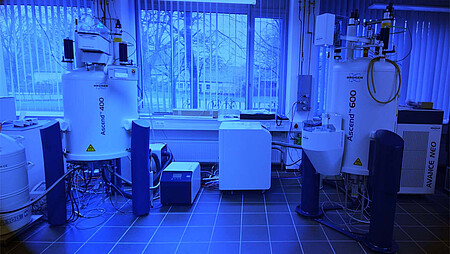Overview
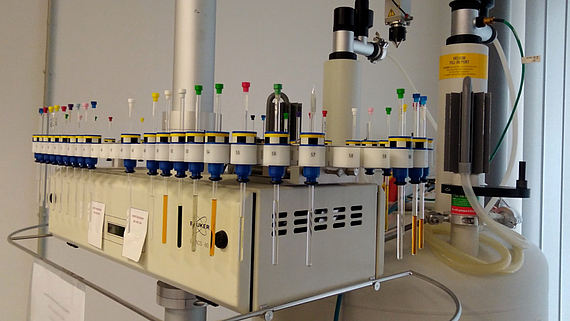
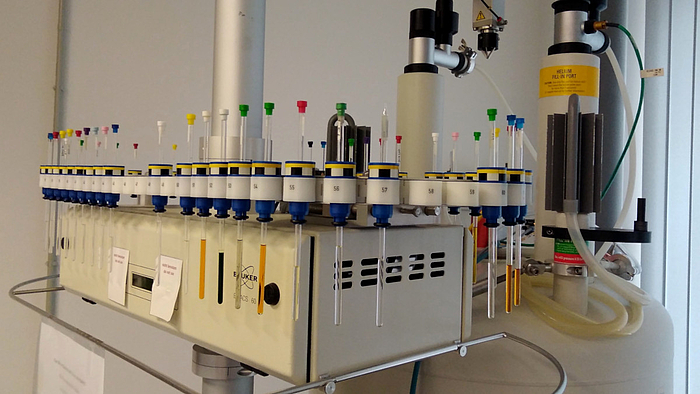
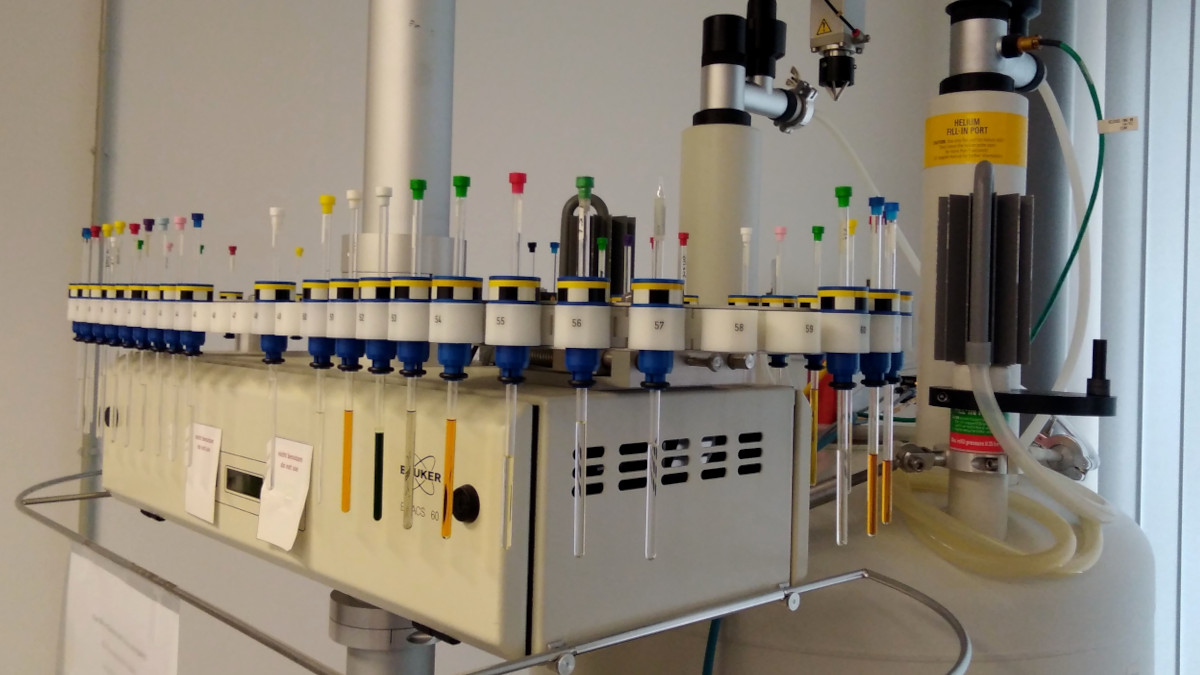
The unit with its five spectrometers is devided into two subsections. An Open Access area with two 400 MHz machines is primarily available for PhD and master students in the Institute of Organic Chemistry for independent submission of standard experiments. In addition, service measurements are perfomed by NMR staff in a separate service unit with another 400 MHz, as well as a 500 MHz and a 600 MHz device. The service is available to all members of the Leibniz University Hanover as well as their cooperating partners. Measurements for external companies can be arranged upon request. Do not hesitate to contact us if you are interested.
Regular NMR users hold an NMR account with an individual identifier which is used to denote the sample number. Single or occasional measurement requests will be dealt with via a guest account. Measurement results are available from an FTP-server. The files are named strictly according to the system summarized in the panel on the left, which should always be followed when measurements are submitted. You can find an overview of all available measurements end their respective abbreviations here.
example name: IDHA001A
- Pos. 1+2: user ID (e.g. ID)
- Pos. 3+4: experiment abbreviation
- Pos. 5-7: sample number (e.g. 001)
- Pos. 8: device-ID (e.g. A for 600 MHz)
Equipment
Open Access Instruments
In room 047, two 400 MHz machines are permanently available for submission of standard measurements by authorized users. Both are equipped with BACS sample changers with 60 holders. Open Access measurements are limited to the following deuterated solvents: CDCl3, CD3OD, DMSO-d6, C6D6, D2O, Aceton-d6, CD3CN. For other solvents or solvent mixtures, please contact the NMR staff for inquiry or submit your samples to the Service directly.
-
Bruker Ultrashield 400 MHz (ULS400 - lefthand side)
1H 1D measurements are priorized on this instrument during daytime (8:30 AM - 10:30 PM) enabling rapid screening at any time (also on weekends). 13C and 2D experiments are scheduled exclusively during the night. Those should preferably be measured on the second Open Access machine (ASC400), which yields significantly improved spectral quality (resolution and signal-to-noise-ratio).
-
Bruker Ascend 400 MHz (ASC400 - righthand side)
Day measurements
- 1H 1D
- 1H-1H DQF-COSY
- short 13C 1D
- short NOAH2_BS (HSQC+HMBC)
Night measurements
- long 13C 1D
- 13C DEPT135/DEPT90/APT
- 1H-13C HSQC
- 1H-13C HMBC
- long NOAH2_BS (HSQC+HMBC)
Day measurements are priorized from 8 AM to 6 PM. If no day measurements are in the queue, night measurements may be started during the day. Saturday and Sunday are defined as night time. Until further notice, data from this instrument are only distributed during working days at irregular intervals.
Service Instruments
Room 035 hosts three more NMR machines (400 MHz, 500 MHz and 600 MHz), which are operated exclusively by NMR staff. Helium and N2-cooled cryoprobes allow for significantly improved sensitivity so that the Service instruments are particularly suited for measurements of low concentration samples and complex larger molecules. In addition, several specific applications are available (see below).
-
Bruker Ascend 400 MHz with BBFO probe
The Service 400 MHz machine is equipped with a Prodigy BBFQ probe and a Sample Xpress sample changer with 60 holders. A broadband channel allows measurement of various heteronuclei. A second channel is used for detection of 1H or 19F.
Specific applications:
- 31P, 19F, 11B,29Si
- 19F-decoupled 13C
- 19F-13C HMQC
-
Bruker Ultrashield 500 MHz with and cryo-probe TCI
The 500 MHz machine is equipped with a Sample Xpress sample changer with 60 holders and a TCI cryo-probe with three channels for detection of 1H, 13C and 15N.
Specific applications:
- 1H-15N HSQC
- 1H-15N HMBC
-
Bruker Ascend 600 MHz with cryo-probe DUL
The 600 MHz spectrometer is equipped with a DUL cryo-probe optimized for the detection of 13C so that 13C spectra may be acquired even for very low concentrated samples. In addition, the non-uniform-sampling method enables acquisition of 2D spectra with extremely good resolution in the indirect dimension on this machine.
Overview of available measurements
1D standard experiments
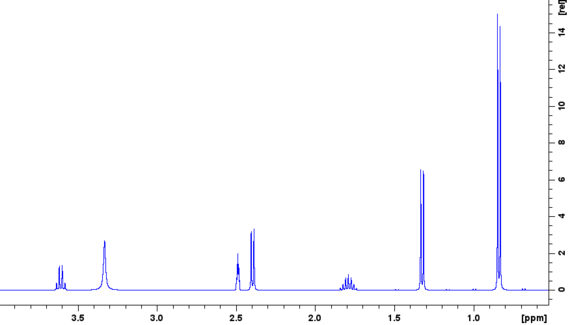
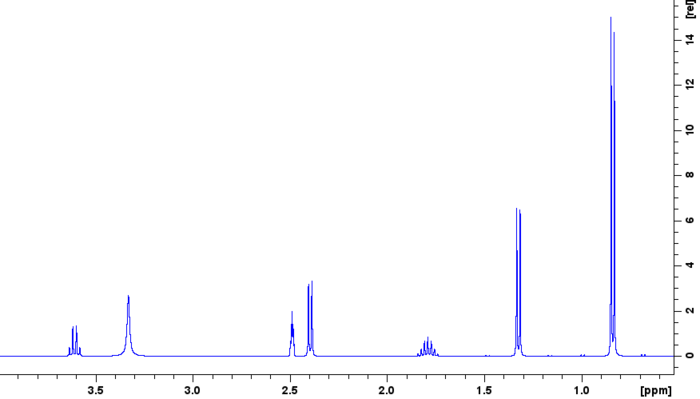
- HA - 1H 1D
- HW - 1H mit solvent/water suppression
- CL - 13C 1D (broadband 1H decoupled)
- CB - 13C DEPT135
- CC - 13C APT
- FA - 19F 1D
- PA - 31P (with or without 1H decoupling)
2D standard experiments
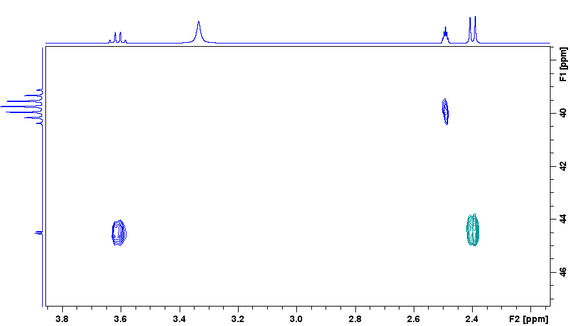
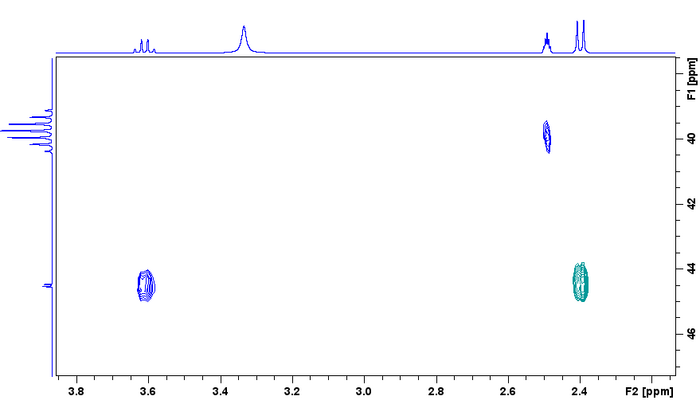

- ED - 1H-1H COSY/DQF-COSY (crosspeaks between scalar coupled 1H resonances)
- MC -1H-13C HSQC (1H-13C correlations accross one bond, CH/CH3 positive, CH2 negative)
- MH - 1H-13C HMBC (1H-13C correlations accross 2-4 bonds)
- BS - NOAH2_BS (BS – combined acquisition of HSQC and HMBC)
Further specific applications
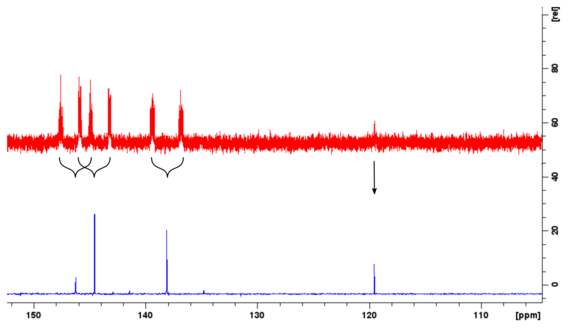
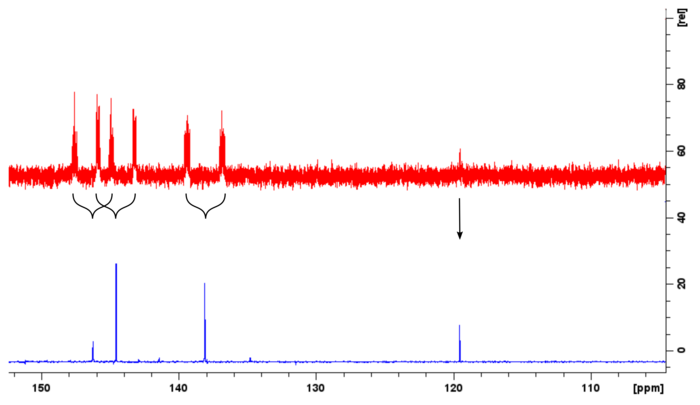
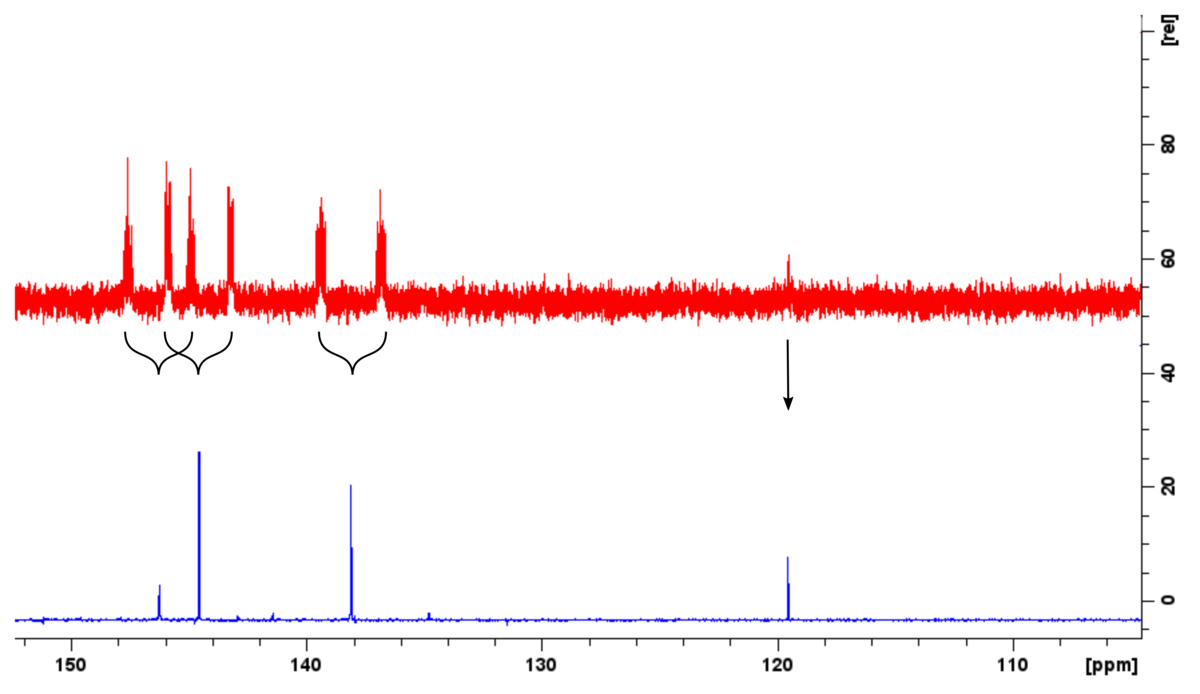
- dipolar coupling-based distance information (1D and 2D NOE experiments, ROESY)
- 1D and 2D TOCSY (signals/correlations within a spin system)
- further heteronuclei (29Si, 11B...)
- specific heteronuclear 2D experiments (1H-15N HSQC/HMBC, 19F-13C HMQC)
- 19F-decoupled 13C
- measurements at different temperatures
Detailed information
-
Water/solvent suppression
A simple water suppression by presaturation for D2O samples is even available in the Open Access (ASC400). On the Service instruments, solvent suppression is applied whenever necessary, adapting the carrier freqeuncy for every sample. For instance, the water peak in DMSO or an intense methanol signal may be suppressed. In addition to presaturation, a variety of more sophisticated solvent suppression schemes are available, allowing for instance the measurement in 10%/90% D2O/H2O.
-
Multiplicities in DEPT/APT/HSQC
Among the 13C experiments, DEPT and APT spectra offer the advantage of discrimination between Cq/CH/CH2/CH3 resonances accorging to the sign of the signal. These measurements are particularly suited for samples without further characterization through heteronuclear 2D experiments. A combination of APT/DEPT with HSQC, on the other hand, is hardly useful, as the latter contains the same multiplicity information in the sign of crosspeaks. An advantage of DEPT spectra is their increased sensitivity. However, they lack resonances of quaternary carbons.
-
2D experiments: resolution in the indirect dimension
Typically, a spectral region of ca. -20 - 230 ppm is selected for the indirect 13C dimension in the if no 13C 1D spectrum has been measured. This usually results in a resolution of ca. 0.5 - 1 ppm (in particular for Open Access measurements). Samples have to be submitted to the Service, if a better resolution is needed. In this case, please specify the required resolution as well as the expected 13C spectral range on the submission form so that the acquisition parameters can be adapted accordingly. An extremely good resolution is available on the 600 MHz machine thanks to the non-uniform sampling technique.
-
NOAH2_BS experiment
The NOAH2_BS experiment can save almost 50% of the measurement time required for HMBC and HSQC by combined acquisition of these two heteronuclear 2D experiments. It should therefore be selected whenever both HSQC and HMBC are needed. Note that BS datasets have to be split into the two sub data sets prior to processing (see information document (pdf)).
-
Dipolar coupling-based distance information
Distance information can be gained based on the nuclear Overhauser effect (NOE), which describes the transfer of magnetization to spins in the vicinity mediated via dipolar coupling. Thus, in a 2D NOESY, correlations are observed between resonances when the corresponding nuclei in the molecule are close to each other (up to 5 Å). Analogous information may be obtained from a 2D ROESY, which is usually superior in case of small molecules. A simpler and faster option is a 1D NOE experiment, for which the analysis is also often much clearer. For the 1D NOE experiment, a list with signals of interest has to be provided (marked in printed 1H 1D spectrum). They will be saturated in individual experiments, and only the signals from protons in close proximity will show a "response".
-
Heteronuclear measurements
In addition to 13C, 31P und 19F are also available as routine measurements on the service 400 MHz spectrometer. As some hardware settings have to be switched for 19F measurements, 19F samples should ideally be gathered and then be submitted in a bundle. 29Si und 11B experiments are also already implemented, but you should ask for specific requirements before submitting such samples. Indication of the chemical shift range of expected signals is highly helpful for all heteronuclear measurements. Implementation of experiments for other heteronuclei may be envisaged upon request.
-
Specific heteronuclear experiments
Common heteronuclear experiments are obviously not only used for 1H-13C correlations. For instance, 1H-15N HSQC und HMBC spectra can be recorded upon request on the 500 MHz machine even at natural abundance. 1H-15N correlationen may significantly reduce the number of possible structures when elucidating the structure of an unkown molecule. In particular, the usually excellent Dispersion of 15N resonances may allow for the eliminiation of structural ambiguity in complex cases with strongly overlapping 13C resonances.
Especially for perfluorinated molecules, 19F-decoupling in 13C sepctra eliminates highly complex multiplicities of 13C signals and thus also yields an improved signal-to-noise ratio. Additionally, 19F-13C HMQC spectra may help with the unambiguous assignment of fluorinated carbons. Please note, however, that with the current equipment simultaneous detection/decoupling of 1H and 19F is impossible.
-
Measurement at various temperatures
As the chemical shift is temperature-dependent, a measurement at a higher or lower temperature can reduce the overlap of signals in a lucky case. However, a much more successful and simpler approach is usually to measure in a different solvent.
The kinetics of chemical exchange processes are also temperature-dependent, for example in tautomerism and rotational or other conformational isomerism. At higher temperatures, the exchange rate increases, so that a fast exchange (sharp averaged signals) can possibly be achieved. At low temperatures, on the other hand, a slow exchange (separate signals for species in equilibrium) may be achieved. In any case, it should be noted that the available temperature range is limited by the melting and boiling points of the solvent used and by the hardware used. In principle, measurements at different temperatures are only offered after personal consultation.
Software for NMR
Topspin
Topspin is a Bruker software for acquisition and processing of NMR data. It is free for all members of LUH or other Universities. Everybody can generate a free academia license after registration with their academic email address. Topspin may be used for processing and visualization of NMR data and offers some useful analysis functions especially for 1D NMR spectra.
MestReNova
LUH holds a campus license for MNova NMR (including qNMR and Reaction Monitoring) which was purchased 2022 initialized by the Chemistry institutes. Mnova NMR includes various functions for processing, visualizing and analysing NMR data and also offers helpfuls tools for NMR resonance assignment. After downloading and installing MNova, the campus license has to be activated (see detailed instructions below).

